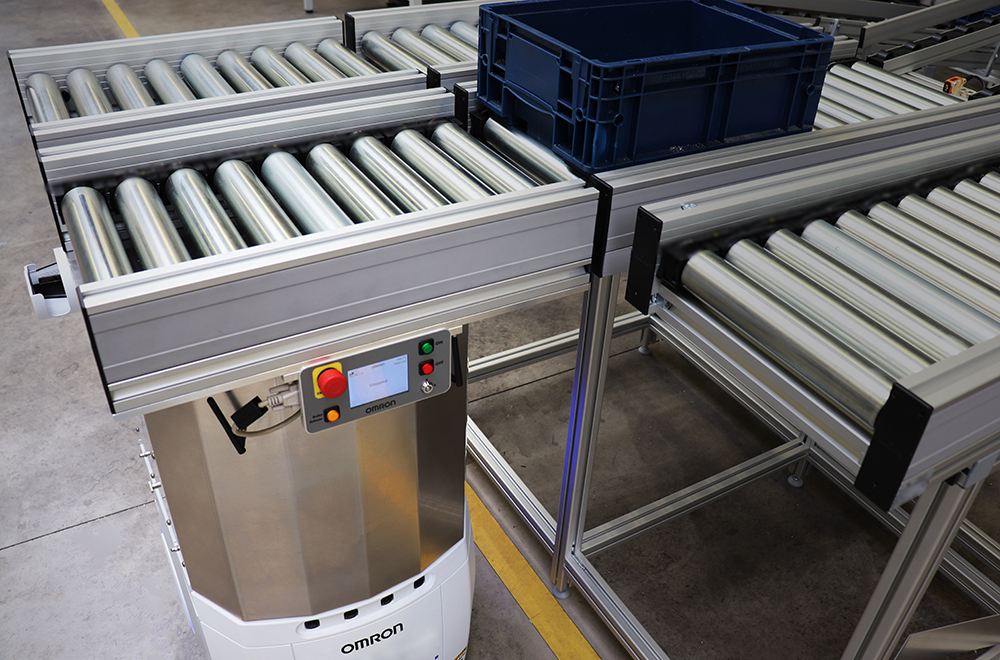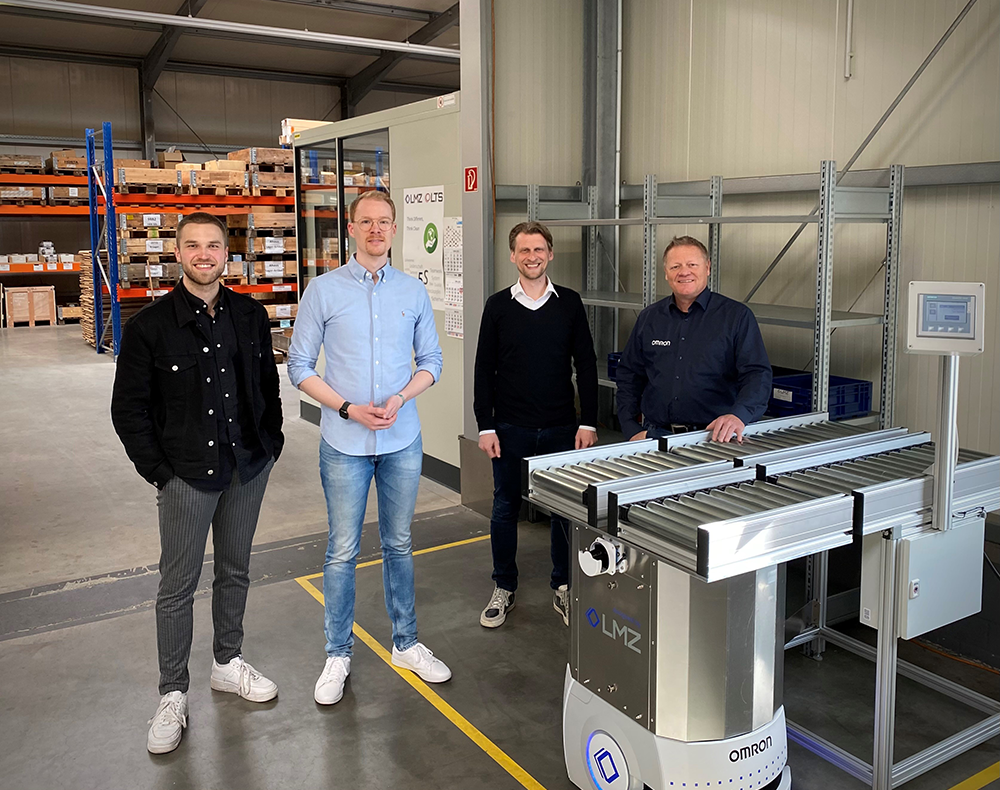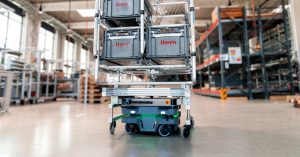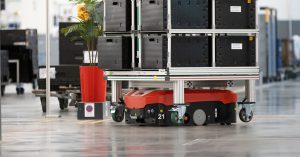No distractions and more time to add value. That is precisely how mobile robots fitted with custom superstructures are optimising in-house material transport.
Whether it’s AGVs (Autonomous Guided Vehicles) or AMRs (Autonomous Mobile Robots), automation is becoming ever more relevant to intralogistics operations. For a long time, companies have focused primarily on optimising the processes that add value, such as in assembly. However, given the skills shortage in factories, it is pretty clear that businesses now need to look at the bigger picture and find new solutions. Another key consideration is that intralogistics tasks often involve physical stresses and strains. Added to that, transport tasks are frequently carried out by staff who end up wasting valuable time they could otherwise be spending on their actual work.
It was this tricky situation that motivated Lenkering Montage- und Zerspanungstechnik GmbH (LMZ) to start offering mobile robotics solutions. LMZ is part of the item pluspartner network and specialises in automation solutions for Industry 4.0. This made its move into AMRs a logical step: “We wanted to expand our portfolio in line with the processes that are going on in our customers’ factories. Although optimising intralogistics is far from a standard approach, the potential is huge. Having our own use case so we can highlight this potential to prospective customers is essential,” explains LMZ’s Managing Director, Dennis Lenkering. That is why the company has optimised material transport in its own workshops – using the LD-60 autonomous mobile robot from OMRON and a modular superstructure based on item profile technology.
Showcasing the potential of autonomous intralogistics
LMZ has four expansive workshops arranged in sequence. The last workshop is home to production operations, where staff mill and turn components that are later assembled to produce LMZ’s specialist machinery. Final assembly takes place in the first workshop. In the past, staff would end up walking back and forth several times a day, moving parts from production to final assembly – and back again if they needed reworking. That would inevitably take them away from their actual job for pretty long periods. “Our customers face the same challenge. These are monotonous and physically demanding tasks. That makes it all the more important to look after your staff and automate activities like these,” points out Lenkering. Investing in suitable intralogistics automation is therefore well worthwhile. However, you have to look at the bigger picture to see the benefits. Although the gains from process automation in assembly can be measured in terms of concrete quality or cost improvements for a specific product, that is not the case in intralogistics. Instead, mobile robots used in these applications benefit production as a whole. That is why LMZ offers its customers aids such as checklists for cost estimates.
OMRON, LMZ and item – the optimum complete all-in-one package for mobile robotics
Transportation processes at LMZ are now taken care of by the LD-60 from OMRON. This model has been customised with a modular superstructure built using the MB Building Kit System. The lower section of this superstructure is clad with sheet metal, while the upper section consists of two electric roller conveyors. The AMR travels back and forth between four stations that have also been built using item profiles. There are electric roller conveyors in the production station, too, and these are connected to gravity-operated roller conveyors from item. When components need to be taken to final assembly, all the staff member needs to do is place the relevant material container on the roller conveyor and use the touch panel to enter the relevant destination. The AMR takes care of the rest. First, the LD-60 drives to the starting station – autonomously and without the need for any markings, as is standard for autonomous mobile robots. When it arrives, the roller conveyors on its superstructure and on the station are switched on and then stopped again in good time. This ensures the container is safely loaded onto the superstructure. Finally, the AMR drives to its destination station for final assembly.
Thanks to the modular nature of item profiles, we have flexibility when it comes to modifying the superstructure and scaling it up or down. The low weight of the profiles is also important, as the mobile robot’s load-bearing capacity is 60 kg and you want to keep as much of that as possible for transporting materials.
As an item pluspartner, LMZ is very familiar with the benefits of aluminium profile technology from item. During the intralogistics optimisation project, these benefits became even clearer, as Lenkering recalls: “Modularity is naturally an advantage. We have flexibility when it comes to modifying the superstructure and scaling it up or down, and that would never be an option with a steel frame. The low weight of the profiles is another important aspect. After all, the LD-60’s load-bearing capacity is 60 kg, and you want to keep as much of that as possible for transporting materials.” Sven Kaluza, Business Development Manager Robotics, Central Region at OMRON, is very clear about the customer benefits and the smooth interplay between the manufacturer and system integrator: “LMZ and OMRON are there to help customers introduce mobile robots, right from the start. LMZ can share its own experience in deploying a ‘co-worker on wheels’ and thereby help build trust in this new technology. For its part, OMRON has an ideal, scalable platform for a whole range of applications. All in all, it is the basis for an exceptional partnership.”

An extra 170 minutes to add value every day – thanks to intralogistics automation
Scalability is another key reason why LMZ opted for OMRON, and it has also since become an official German distribution partner and system integrator for the Japanese company’s LD series. The payload capacity of the series ranges from 60 to 1500 kg. Thanks to intelligent fleet management, solutions can be scaled perfectly to suit pre-existing structures: “In most cases, you start out with a single AMR. What really matters is that you can subsequently scale the concept to end up with a whole fleet of mobile robots. The result is an opportunity to seamlessly integrate the transportation of a huge range of components – from small parts to heavy loads. Fleet management brings it all together,” says Torben Fangmann, Marketing Manager at LMZ. When combined with modular item profile technology, this provides the perfect basis for developing bespoke solutions. Depending on the transport task and space, LMZ will compile the optimum combination of AMR and customised superstructure for its customer. There are countless additional options, such as fastening a cobot to the AMR superstructure. This cobot could be used to pick a material container out of a rack, hold it on the superstructure during transportation, and then tip the contents into a funnel on reaching the production machine.
All in all, the automation in our logistics operations is saving us 170 minutes in working time every day. Customers have also been showing a lot of interest in AMR solutions.
Despite all the captivating opportunities and options, just as with any other innovation project, it makes sense to take everything step by step when rolling out AMRs. “As a system integrator, we always recommend that our customers start with a single robot. It’s important to take the first step, but we always advise against rushing the switchover from manual operations to automated solutions. Firstly, if you move too fast, you’ll leave your workforce behind. Secondly, you might find things don’t work out on a technical level, either,” emphasises Lenkering. What really does matter is making sure your staff understand that your aim is not to make them redundant, but to give them targeted support. They will have to work with their robotic colleagues on a daily basis, so it is also important to have an appropriate design, like that used for the solution at LMZ. For intralogistics automation to work, staff expertise also has to be integrated into the process. For instance, only the workers on site know the exact layout of a workshop and where potential pitfalls could lie. That’s why the best approach is to run a pilot project with one AMR and get your staff involved. This is exactly what LMZ did for its in-house optimisation project, and the company’s Managing Director is very happy with the result: “It has been a complete success. We are seizing on another issue that is shaping the future and, all in all, the automation in our logistics operations is saving us 170 minutes in working time every day. Customers have also been showing a lot of interest in AMR solutions.”






